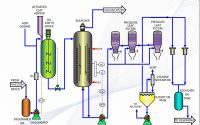Sunflower oil manufacturing process
1. Sunflower oil pre-press process
Sunflower→ Magnetic seperating( Metal impurities)→ cleaning→ husking→ flaking roll→ Cooking→ pressing workshop
First, use magnetic separator, de-stonner and vibrate cleaning sieve to remove metals, small stones, impurities from sunflower raw seeds.
Second, use husking machine to remove husks, separating screen to separate husk and sunflower kernel , here separating screen must not separate completely, or it will be too slippery for oil pre- press.
Third, cooking sunflower seeds are ready for oil pre-press.
Fourth, pre-presse sunflower seeds. Here only pre-press part of sunflower oil, oil residue inside cake (about 12-16%) will be extracted in oil extraction process. After pre-pressed, the crude sunflower oil will be delivered directly to sunflower oil refining, and pressed cake to oil extraction.
2. Sunflower oil extraction process
Crude sunflower oil→ degumming→ deacidification→ decolorization→ deodorization→ refined sunflower oil.
First, use solvent to extract oil from sunflower oil cake inside oil extractor, and the final products are mixed oil and wet meal.
Second, the mixed oil will pass through two evaporators to make solvent inside transform into gas , and solvent will be recovered through condensers and reused. These two evaporators are not with same size , the first evaporator is bigger than the second one because there are more solvent inside mixed oil in the beginning . After evaporating, the oil will be pump into the stripping tower. Finally, we will get crude sunflower oil ready for oil refining.
Third, the wet meal will be delivered to desolventizer to dry and be separated with solvent. The dry meal will be packaged for sale as animal feed, in which oil residue inside meal is less than 1% .
3. Sunflower oil refining process
First, hydrated degumming, mainly is to remove phosphatide inside crude sunflower oil in order to reduce oil loss and improve quality of oil .
Second, alkali refining, using alkali to neutralize free fatty acid with by-product of soapstock, which is used for making soap.
Third, decoloration using bleaching clay to absorb darker colorant inside crude oil.
Fourth, deodorization is using high temperature to remove the impurities with bad smell .
Fifth, dewaxing is using low temperature to freeze wax inside refined oil and then separate wax with vibrating screen.


